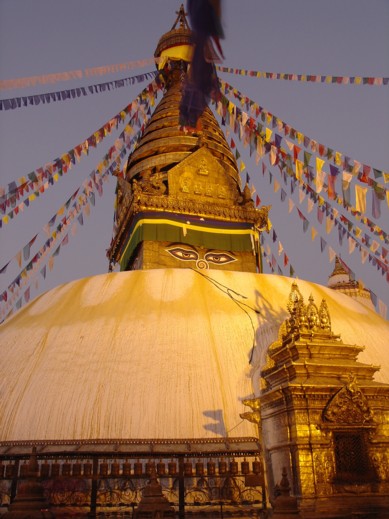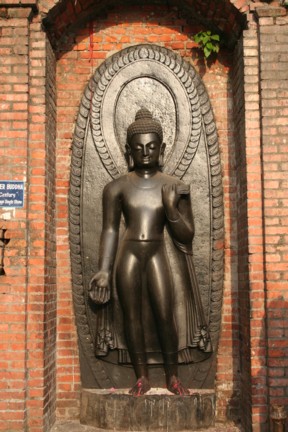Swayambhunath

Swayambhunath Stupa (Skt. Svayaṃbhūnāth Stūpa; Eng. The Self-Arisen Stūpa) known as Phakpa Shingkün in Tibetan (Tib.འཕགས་པ་ཤིང་ཀུན་, Phakpa Shingkün; Wyl. 'phags pa shing kun; Eng. Sublime Trees of All Kinds) — one of the most sacred stupas in Nepal, is perched atop Semgu hill on the western outskirts of the Kathmandu valley. The forest covering the hill is filled with families of monkeys, a home which has earned it the nickname, “The Monkey Temple.”
Along with the stupas at Boudhanath and Namo Buddha, Swayambhunath is considered by Buddhists to be among the most important pilgrimage places in the world. It was described by Kathok Situ Chökyi Gyatso (1880~1925) as “a sacred shrine of universal value for the people of the Indian subcontinent, unsurpassable for accumulating merit and good fortune.” Trulshik Rinpoche (1924~2011) said that the Swayambhunath Stupa carries the blessings of thousands of buddhas, and that it will continue to be blessed by all the buddhas of the current aeon. According to the Seventh Dalai Lama, this very stupa is the source of all the happiness in the world. The significance of this has led the Newar Buddhists of the Kathmandu valley to revere the site, while Buddhist practitioners from both India and Tibet have been gathering here for centuries, to pay homage.
The site thus provides an intimate point of connection between the well-being of the buddhadharma throughout South Asia and its flourishing in Tibet as well.
The origin of this stupa is recounted in the Swayambhu Purana,[1] which details the history and significance of every major Buddhist site within the valley. For Tibetan Buddhists, this text has long been the main source of information on the sacred sites of Nepal.
The Main Stupa
Swayambhu means self-arisen. This particular stupa complex was built, according to different traditions, either around a small crystal stupa that arose spontaneously on top of this hill, or a lotus flower, which naturally radiated light, at the time of the Buddha Shikhin. The Swayambhunath Hill which, according to Trulshik Rinpoche, has been blessed by thousands of buddhas and will be blessed by all the buddhas of this kalpa, is often considered the most sacred spot in the whole of the Kathmandu Valley.
According to the traditional accounts the stupa was in the middle of a vast lake when Mañjushri and two friends saw it on their way from Wu Tai Shan in China to Nepal. Mañjushri found the stupa to be so incredible that he wondered how he might make it possible for pilgrims to walk to the stupa for their devotional practices. So he cut the mountain with his sword and the water poured out for four days and four nights, producing the Madara Lake (Wyl. mtsho ral gri) in Chobar in the South-East of Kathmandu, which is on the way to Pharping.
There is a prophecy that when two fangs come to eat the stupa at Swayambhunath, this will mark the beginning of the decline of Buddhism in Nepal. The Fourth Khamtrul Rinpoche, Tenzin Chökyi Nyima (1730-1780) said in his Pilgrim's Guide to the Kathmandu Valley (Wyl. kham sprul gnas yig) that this refers to the two Hindu temples, which resemble fangs, and which were built a few hundred years ago on either side of the main staircase. Approximately 200 years ago the northern one collapsed, which made the Buddhists of the valley happy, until the government decided to rebuild it. The stupa is surrounded by a number of temples.
According to the Pema Kathang, Guru Rinpoche hid many termas in Swayambhunath. This is also the place where Marpa Lotsawa first heard of the name of Naropa and stayed for three years “to get used to the heat”, according to the instruction of his Newari master. It is also said that Thangtong Gyalpo traveled to the stupa in a single instant through his magical power. Five days later a rich person made large offerings to him, which he used to whitewash the stupa.
Tibetans circumambulate the stupa itself (nangkhor) or the whole hill (pharkhor). They call it phakpa shing kun (Wyl. 'phags pa shing kun), “Sublime Trees of all Sorts”. Authorities do not agree on the origin of the term, but the most prevalent account is that on one occasion the great master Nagarjuna cut off his hair and scattered it about, praying, “May all kinds of trees grow on this sublime Stupa!” After this many species of tree grew tall around the stupa.
The Immediate Vicinity of the Stupa
Vajradhatu Mandala
At the head of the stairs is an impressive gilt vajra borne on top of a smooth base of gilt copper, representing the dharmadhatu, in the form of the mandala of Mañjushri. It was placed there by the Nepali king Pratapmalla, who was also responsible for the construction of the two fang-like shrines and the eastern stairway in the 17th century.
Hariti—the Protectress of Children
Right behind the main stupa, opposite the main stairway, is the temple of Hariti, Protectress of children, to which children are often brought, almost as soon as they are born. There are often long queues here, especially early in the morning.
When the Buddha met Hariti she was eating her children. The Buddha asked her to stop, but she replied, “If I don’t eat my own children, what else am I going to eat?” The Buddha then said that from then on all his followers would leave her the fist portion of their meal.
The site has inspired many superstitions and features in several legends. According to one account, there was once a time when everything in Nepal was going wrong, and after a while they found that the temple was damaged. But the people couldn't repair it. So they called the then Shamar Rinpoche, who had always a very strong connection with Swayambhu. He demolished the temple, as he was the only one with the power necessary to do so, and rebuilt it.
Khamtrul Rinpoche wrote about this temple in the 18th century: “I have noticed that Tibetans consider Hariti as of minor importance because she is a yakshi. While they do visit the shrine, they do so only while disparaging her and without presenting her due homage or offerings. This is really a foolish way to act, and is the behavior of people who have heard only few teachings.”
He explains, “Generally speaking, it is indeed true that she is not an object of refuge equal in importance to the sacred representations of buddhas, bodhisattvas, lamas, yidams and so on. Yet, neither is she in any way similar to the minor spirits, such as the local deities of the region, or of a particular place. Among the powerful gods intent on positive activity after they had come into the presence of the Buddha and seen his face, and who are worthy of homage, some gained major importance, even though in the Dharma scriptures such as Vinaya they are not specifically referred to or associated with technical terms such as “dharmapala” and “guardian deities”; whereas in actual meaning they do function as guardian deities (in these accounts). It is for this reason that the Buddha himself has said, “Those who vow to take me as their teacher should offer a first piece of each meal to the Yakshi Hariti.”
He adds, “Hence we should understand the matter as follows. Having met the Buddha face to face, she became a guardian of his teaching and as such became as worthy of homage as the sacred Dharma itself. Thus it is that while recollecting her excellent qualities, with great respect and with a pure mind, we should offer her homage.”
So she was given the charge of protecting the Swayambhu stupa, and according to some accounts, when the two fang-like temples were built, the image clearly produced many miraculous interventions to show her displeasure.
Buddha Statue

Behind the Swayambhunath stupa itself is an image of a standing Shakyamuni Buddha made of black stone. The Fourth Khamtrul Rinpoche, when he came here in the 1700s, said that this was one of the most sacred power places in the Kathmandu valley.
Small Stupas and Images
There are many statues of deities and stupas of mixed Hindu and Buddhist content, of all dimensions. Most of these were sponsored by kings, brahmins, wealthy householders or other devotees from the city of Kathmandu, from the earliest times to the present day.
Further Away On the Hill
Vasubandhu Stupa
The great master Vasubandhu spent time in Swayambhu. According to legend, he once was sitting exactly where his stupa is now, and, looking over the fields down the hill, he saw a monk, who had taken off his robe and wrapped it around his head to shield him from the sun, ploughing the field. On seeing this, Vasubandhu exclaimed, "Well, if this is the state of the Dharma, then there’s no point in me hanging around," and with that, he recited the dharani, or long mantra, of Ushnishavijaya backwards, his head split apart, and he passed away. His body was later placed inside this reliquary stupa.
Chakrasamvara Mandala
Down on the right from the main stupa is a building which houses—and also quite a lot under ground—a huge three-dimensional mandala of Chakrasamvara. There are five layers, according to the five kayas. Behind the door, there’s a little courtyard where people place offerings and so on. There are murals inside, which are centuries old and have been preserved quite well. Inside there are several doors going down into this huge mandala complex of Chakrasamvara. It is said to be the Chakrasamvara power spot in the Kathmandu valley.
Once there was a king of Nepal who wanted to become the grand Maharaja of all Asia. So he came here to acquire some powers. He went inside, but didn't reappear for a number of days. When he came out he was completely insane. Whenever the inside is opened, the outside door is locked and people would usually rattle around [what?] and be ushered away. Only Newari vajra masters can enter the inner chambers.
Manjushri Hill
The Manjushri Hill is the place where the first Newari vajracharyas received their respective empowerments for the first time in the whole of Nepal. The reason it is called Mañjushri Hill is not so clear. Some think it might be because the first empowerment given here was the Mañjushri Nama Sangiti, given its popularity and prevalence throughout the valley.
Further Reading
- Situ Paṇchen: His Contribution and Legacy, Lungta 13, Amnye Machen Institute, Summer 2000
- ↑ Puranas (“tales of old”) is a genre of Hindu scripture which constitutes a vast body of literature. Puranas entail historical information blended with legend and myth. The Swayambhu Purana is an exceptional case, being the only Buddhist text that associates itself with the puranas.